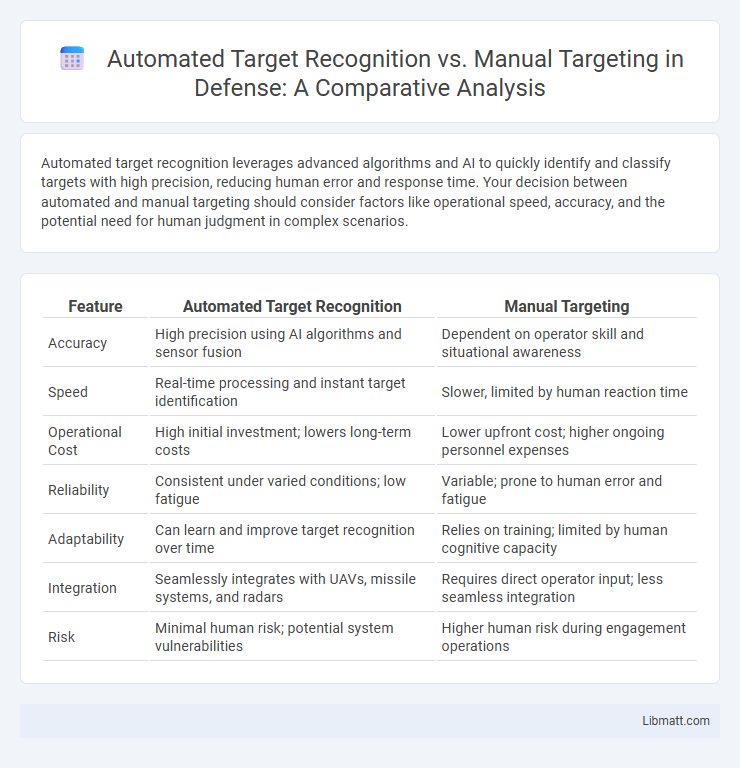Automated target recognition leverages advanced algorithms and AI to quickly identify and classify targets with high precision, reducing human error and response time. Your decision between automated and manual targeting should consider factors like operational speed, accuracy, and the potential need for human judgment in complex scenarios.
Table of Comparison
| Feature | Automated Target Recognition | Manual Targeting |
|---|---|---|
| Accuracy | High precision using AI algorithms and sensor fusion | Dependent on operator skill and situational awareness |
| Speed | Real-time processing and instant target identification | Slower, limited by human reaction time |
| Operational Cost | High initial investment; lowers long-term costs | Lower upfront cost; higher ongoing personnel expenses |
| Reliability | Consistent under varied conditions; low fatigue | Variable; prone to human error and fatigue |
| Adaptability | Can learn and improve target recognition over time | Relies on training; limited by human cognitive capacity |
| Integration | Seamlessly integrates with UAVs, missile systems, and radars | Requires direct operator input; less seamless integration |
| Risk | Minimal human risk; potential system vulnerabilities | Higher human risk during engagement operations |
Understanding Automated Target Recognition (ATR)
Automated Target Recognition (ATR) employs advanced algorithms and machine learning techniques to identify and classify objects rapidly and with high accuracy, surpassing the limitations of human perception in manual targeting systems. ATR systems leverage data from sensors like radar, infrared, and optical imagery to enhance situational awareness and reduce operator workload. This technology improves decision-making speed and target engagement precision in military and surveillance operations.
Overview of Manual Targeting Methods
Manual targeting methods rely on human operators to identify and track targets using visual, infrared, or radar data, leveraging experience and situational awareness to assess threats. These methods often involve direct control of weapon systems, requiring continuous operator input and decision-making under varying conditions. Despite slower reaction times compared to automated systems, manual targeting allows for nuanced judgment in complex or ambiguous scenarios.
Key Technologies Behind ATR Systems
Automated Target Recognition (ATR) systems leverage advanced technologies such as machine learning algorithms, deep neural networks, and radar signal processing to accurately identify and classify targets in complex environments. These systems integrate sensor fusion from sources like LiDAR, infrared, and synthetic aperture radar to enhance detection capabilities beyond the limitations of manual targeting, which relies heavily on human operator interpretation and reaction. Key components like real-time data analytics and adaptive pattern recognition enable ATR to improve precision, reduce false positives, and accelerate decision-making in defense and surveillance applications.
Human Decision-Making in Manual Targeting
Human decision-making in manual targeting relies on cognitive judgment, experience, and situational awareness to identify and engage targets, often resulting in slower response times compared to automated systems. Manual targeting is prone to errors due to fatigue, stress, and limited perception, impacting accuracy and reliability in high-pressure combat scenarios. Advanced training and real-time intelligence are critical to enhancing human performance and mitigating risks associated with manual decision processes.
Accuracy Comparison: ATR vs Manual Targeting
Automated target recognition (ATR) systems consistently outperform manual targeting in accuracy by utilizing advanced algorithms and real-time data processing to reduce human error and improve detection precision. Studies indicate ATR achieves target identification rates exceeding 90%, whereas manual targeting accuracy varies widely depending on operator skill and environmental conditions, often falling below 75%. Enhancing Your operational effectiveness through ATR integration significantly minimizes false positives and target misclassification compared to traditional manual methods.
Speed and Efficiency in Target Identification
Automated target recognition systems leverage machine learning algorithms to analyze vast datasets rapidly, significantly reducing the time required for accurate target identification compared to manual targeting processes. These systems enhance operational efficiency by processing real-time sensor data with high precision, minimizing human error and fatigue. Consequently, automated methods deliver faster, more consistent identification outcomes in dynamic and complex environments.
Reducing Human Error with Automation
Automated target recognition significantly reduces human error by leveraging advanced algorithms and machine learning to detect and identify targets with greater precision than manual targeting methods. Your operations benefit from consistent accuracy and faster decision-making, minimizing the risks associated with fatigue or distraction in human operators. This technology enhances situational awareness and operational efficiency, delivering improved outcomes in complex environments.
Situational Awareness and Contextual Judgments
Automated target recognition enhances situational awareness by rapidly analyzing vast amounts of sensor data to identify potential threats with high precision, reducing human error and response time. Manual targeting relies on human operators to interpret complex contextual cues and make nuanced judgments based on experience and situational understanding, allowing for adaptable decision-making in ambiguous environments. Combining automated systems with human oversight optimizes target identification accuracy while preserving essential contextual awareness and judgment flexibility.
Ethical Implications of Automated Targeting
Automated target recognition systems raise ethical concerns due to their reliance on algorithms that may lack human judgment and accountability, potentially leading to unintended civilian casualties or biased decision-making. Manual targeting involves direct human oversight, ensuring ethical considerations and contextual awareness guide engagement decisions, but it also risks slower response times and human error. Balancing your operational efficiency with the ethical responsibility to minimize harm is crucial when evaluating the deployment of automated targeting technologies.
Future Trends in Target Recognition and Engagement
Automated target recognition increasingly leverages advanced AI algorithms and machine learning to enhance precision and speed, minimizing human error and enabling real-time decision-making on the battlefield. Manual targeting, while reliant on operator expertise and situational judgment, faces limitations in processing speed and scalability against emerging threats. Future trends indicate a growing integration of automated systems with human oversight, ensuring that Your engagement strategies benefit from both rapid data analysis and critical human intuition to improve accuracy and mission success.
Automated target recognition vs Manual targeting Infographic

 libmatt.com
libmatt.com